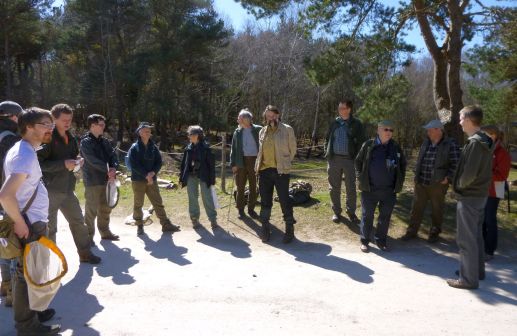There were well over 60 people in attendance at the National Federation for Biological Recording's (NFBR's) annual Conference at the splendid venue of the Royal National Lifeboat Institution's College at Poole, Dorset, on 18th-19th April. Considering it was not a subsidised event, this was a pretty good number.
It was spread over three days in all – a worskshop on Thursday, the main Conference (with the NFBR's AGM etc.) on the Friday, followed by a Saturday for some delegates on a field visit to carry out recording for the National Trust's Diver Project at Studland Heath Nature Reserve.
The Thursday afternoon workshop was led by Sue Townsend of Field Studies Council and Graham Walley, NFBR Chairman, and chaired by David Roy of the Biological Records Centre (who stepped in at the last minute to replace Michael Pocock from CEH). Their theme was to explore whether delegates considered the UK has sufficient resources to support all the biodiversity initiatives that have flowed from the Government over the last couple of years, and if not, what are the main shortfalls. The basic answer was 'no' – and that a serious approach to formulating a practical information strategy with partner organisations is essential.
The Friday Conference followed, for which we had asked speakers to give presentations in the first instance that demonstrated some of the current activities that are being undertaken at the local level, and to show what local/regional thinking is on recording and the use of biodiversity data. This was quite deliberately in response to the somewhat top-down agenda of last autumn's NBN Conference. To start off we had a talk from Nicky Court from Hampshire about the vast array of work being carried out through Hants Biodiversity Iinformation Centre and its partners in survey and the use of data in a wide range of planning and land management work. It was quite exhausting just listening to her!
Andy Foster and David Brown of the National Trust talked about NT survey activity in general and the Cyril Diver Project at Studland in particular, where grass-roots volunteers are being co-ordinated to carry out intensive survey to measure change in an important habitat over 70 years. The NT work in general is carried out increasingly with volunteers as well as in-house survey teams, and is NT's response to the percveived importance of their holdings.
Then we had a review of the 'Heartwood Project' being led by the Woodland Trust in Hertfordshire, by Dr Linda Smith of the Hertfordshire Natural History Society. Her talk was about the engagement of entirely volunteer survey and monitoring personnel to monitor the establishment of the UK's largest habitat re-creation schemeas it progresses.
Paula Lightfoot gave us a very good talk about Seasearch UK's use of volunteers to provide survey data on marine species around the coast, in support of Marine Conservation Zones proposals. Her principal message was that, despite enormous amounts of effort, and good quality data, the Government seemed to ignore most of the findings with its poor response, which has not been a good message to the volunteers involved.
The afternoon session changed tack somewhat to review the same issue discussed in the workshop, with specific emphases. Dr Roger Morris of Dipterists' Forum reviewed the background to his recent paper in British Wildlife, where he looked at the issue of not just recruitment of new recorders, but especially the need to motivate and retain motivators and leaders themselves. His message – that we have relied too long on the few (ageing) 'experts' to do the work without providing the support necessary to ensure we get new generations of 'motivators' to come along behind. He suggested apprentices and financial support.
Martin Harvey looked at the mismatch between national recording effort (Schemes etc.) and local recording, and what can be done about bridging the gap, citing new technologies as a way forward, such as iSpot and iRecord.
I then spoke [for my first time at a NFBR Conference!] on the use of species data in identifying large and small scale conservation priorities, focusing on the way we identify 'habitat indicators', and how, with some more work, a whole lot of better outcomes might be achievable, through using species trait and attribute data alongside other environmental data in a systematic way.
Finally, Tom Oliver from CEH talked about the use of data for assessing 'habitat resilience', and how this relates to 'ecosystem services'. His message was similar to mine, focusing on priorities through analysing data, using models as a mechanism. He also stressed that more investment is needed to take this forward, re-iterating the key messages from the Lawton report – that what we need for not just wildlife conservation, but for human well-being is a 'more, bigger, better, and joined-up' natural environment. Coincidentally, this very theme had been highlighted at the beginning of the workshop on the Thursday by Graham Walley, which led to our discussions about the need for better data collection in order to achieve these very aims.
The Saturday was an addition to the usual programme, and proved very interesting for those that took part, as we were introduced to the way the Diver Project (named after the first Chairman of the Nature Conservancy in the 1950s) is being developed, and met some of the key volunteers taking part. Various Conference delegates took part in carrying out recording in different parts of the site, and their records (although early in the season) will be fed into the growing database being compiled by the National Trust.
At the Conference, the NFBR was formally inaugurated under its new name of the National Forum for Biological Recording, and is now established as a charitable trust, with the aim to provide a venue and direct support for biological recording especially in the voluntary sector.
Written by Trevor James

